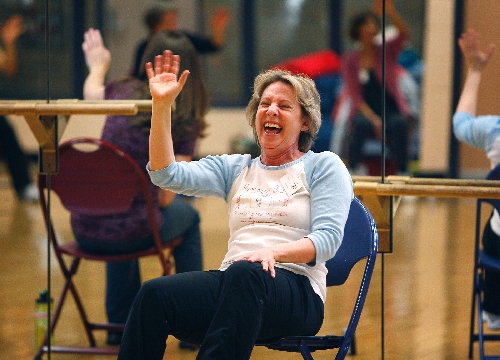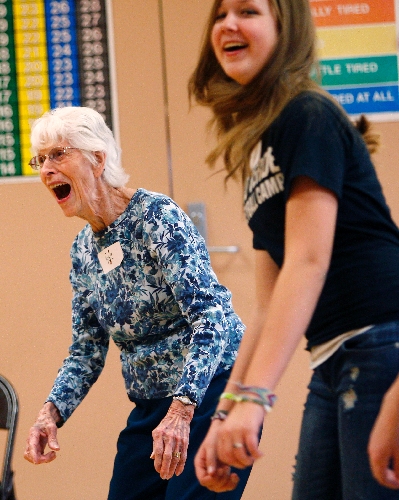Laughter yoga: Cackling your way to better health
They laugh about their credit card bills. They laugh about their aches and pains. They laugh about the medication they have to take.
They laugh about everything in laughter yoga. That's the point.
About 30 women and one man sit in a circle at the Las Vegas Veterans Memorial Leisure Center. They each came to take part in laughter yoga, "a global movement for health, joy and world peace" that takes place here the last Saturday of every month. The exercise room's glass windows let passers-by take a peek at the crowd. About five minutes into the class, they all appear to have just heard the most hilarious joke ever delivered.
Instructor Suzanne Pappas squats down to support the heft of her laugh as her cheeks turn red and her veins surface. She grabs her belly and tosses her head back, too. Laughter yoga isn't about yoga. There are no downward dogs here, just basic stretches performed while sitting in chairs. Laughter yoga isn't about chuckling, either. It's about exploding with the kind of laughs you feel in your belly and in your soul.
Research from the University of Maryland School of Medicine has found that hearty laughter reduces one's risk for cardiovascular disease, while studies from Loma Linda University find that it reduces stress and blood pressure and increases endorphins.
It's mostly the endorphins, the feel-good stuff, that brings students to class. It lets them put their worries and problems aside for just one hour a month as they laugh their hearts out.
"If you put effort into your laughter, you don't get into your thoughts anymore," Pappas says. The more physical the laugh, the more your body commits to the feeling it brings.
Instructor Betty Evans sums it up when she tells the class about one of the primary rules: eye contact.
"It keeps us here in the moment," she says. "Don't think about the kids at the baseball field or taking care of the husband. ... Engage. Let yourself go."
Wanda Isaacs just hopes to take her mind off her arthritis. Other than that, the 69-year-old's expectations for this morning's class are simple. "To be happy when I leave," she says. "I don't laugh very often. Life gets too serious."
Indeed. The longer we live, the less we laugh. As children, it's natural to laugh. As parents to children, it's natural to laugh. As seniors, sometimes, it's hard to laugh. Even if you're attending a class called laughter yoga.
As Isaacs stands to do the first exercise, she shows just how uncomfortable forcing laughter can feel. The class is asked to shake hands with classmates, but not to say their names. Instead they should say, "Aloha -hahahaha!" and really make the "ha's" heard.
The idea is to fake the laughter until it becomes genuine. Isaacs covers her mouth with one hand and sheepishly looks around for the next hand to shake, releasing short laughs in between.
Taylor See, 13, came with a friend whose mom attends the class. She looks embarrassed by the silliness of the "Aloha-hahahah!" greeting. What do 13-year-old girls do when they're embarrassed? They laugh. See makes for an unintentional good student.
It took others a little longer to catch on. One student who suffers from diabetes had a particularly hard time adjusting to the class and all its glee. Her first couple of visits were full of complaints: this hurts, that hurts. It has been months since instructors Pappas and Evans have heard anything but positivity come from the woman who now sits smiling the whole way through class.
The more we age, the more we experience adversity, Pappas says. The more traumatic the event, the more difficult it is to overcome it. All it takes, though, is that first step. Or that first laugh.
"Just like you lose muscle tone," Pappas says, "you lose your ability to laugh."
Isaacs is slowly finding hers. The shoulders under her tangerine T-shirt shake a little more with every minute of the hourlong class that passes. Her smile turns from nervous to genuine.
As a transition between each new exercise, teachers break into a cheer that looks more appropriate for a group of preschoolers. "Ho, ho, ha, ha, ha!" "Ho, ho, ha, ha, ha!" they say, breaking into a patty cake-type of clap. "Very good!" comes next with the thumbs up at the waist. Another "Very good!" follows with the thumbs up at the shoulders. They end the chant with a big "Yay!" as their arms are extended in the air and fingers wave with excitement.
Part of the three-day licensing to become a laughter yoga instructor requires a commitment to teach free classes. Pappas and Evans do just that at the Adult Day Care Center of Las Vegas, where Alzheimer's patients now recognize them when they walk through the door and immediately break into "Very good! Very good! Yay!"
"We get a lot out of it," Evans says.
And they put just as much into it.
Today the two regularly take sips from water bottles to hydrate themselves, which is necessary after all the guffaws of laughter. They ask students to mime the act of opening a credit card statement, grabbing a part of their body that gives them pain, even taking their medication. After each mime, they act as though each source of frustration is actually hilariously funny.
When they're done laughing, they go back to their credit card bills, their aches and pains, and their medicine cabinet full of pills. But it looks and feels much different.
"I can't remember when I laughed this hard," says Isaacs after the class cool down. "I really can't."
Contact feature writer Xazmin Garza at xgarza@reviewjournal.com or 702-383-0477. Follow her on Twitter @startswithanx.
LAUGH THIS WAY
Veterans Memorial Leisure Center is at 101 N. Pavilion Center Drive, 229-1100. Membership fees for the center range from $4 daily to $29 monthly. Email Suzanne Pappas at suzannepappas@hotmail.com. Log onto laughteryoga.org for more information.































